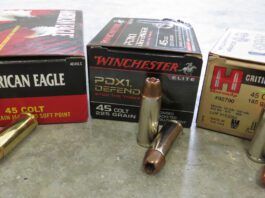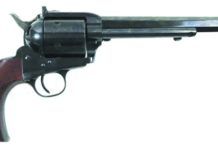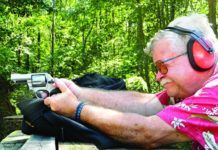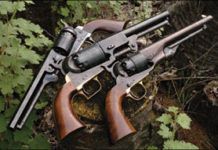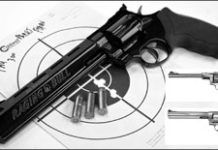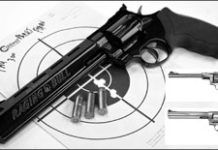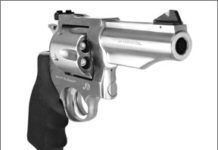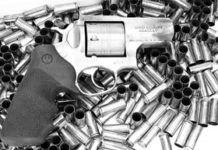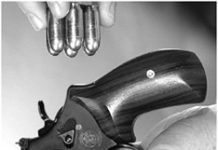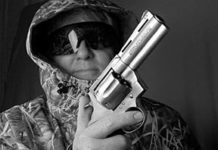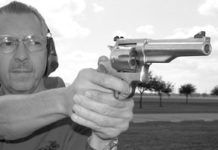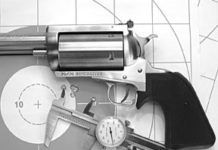Big-Bore Single-Action Revolvers From EAA, BFR, and Cimarron
While the 45 Long Colt could be considered big medicine in a single-action revolver, single-action revolvers chambered in 44 Magnum really up the ante. The 44 Magnum is a substantial cartridge, so a substantial and strong revolver is required to fire that round. We took a look at three single-action revolvers chambered in 44 Magnum — the EAA Bounty Hunter, Cimarron's Bad Boy, and the BFR Short Cylinder housed under the Magnum Research (Kahr) name — and found all three of these powerful revolvers had good attributes, managed recoil well without causing carpal-tunnel syndrome, and were accurate.
Prior to testing, we ran range rods down the barrel to check chamber and bore alignment and found everything was in spec on all three revolvers. Because the 44 Special cartridge can be fired in revolvers chambered in 44 Magnum, we tested all three with Hornady's Critical Defense 44 Special ammo loaded with a 165-grain FTX bullet. For 44 Magnum loads, we chose one of our long stand-by rounds from Black Hills loaded with a 240-grain JHP and a newer load from SIG loaded with a 240-grain V-Crown JHP. All rounds provided excellent accuracy. Because the EAA had fixed sights and the BFR and Cimarron had adjustable sights, we leveled the playing field and tested the EAA at 15 yards and the BFR and Cimarron at 25 yards. The sight picture with the adjustable-sight revolvers was far superior than the sight picture with the fixed sights, though the fixed sights of EAA were a modern take on the classic fixed sights. The EAA and BFR were also drilled and tapped to mount a scope.
Five-Shot 44-Caliber Revolvers From Ruger, S&W, and Taurus
The medium-frame 44-caliber revolver, whether chambered in 44 Special or 44 Magnum, is a great outdoors revolver, often used for defense against animals. We agree that this is a formidable combination, but it also demonstrates formidable recoil, perhaps a step beyond what's necessary to do double duty as a personal-defense round day to day.
To see how a trio of wheelguns would do when pitted against each other at the range, we selected the Ruger GP100 1761 44 Special, a Smith & Wesson Model 69 Combat Magnum 10064 in 44 Magnum and a Taurus Tracker, also in 44 Magnum. All are stainless-steel five-shooters, weigh within a few ounces of each other, and have similar features. The Smith & Wesson Model 69 Combat Magnum is a new version with a 2.75-inch barrel and round butt. The Taurus Tracker 44 Magnum has a 4 inch barrel. The Ruger GP100 chambered in 44 Special is a relatively new introduction, being introduced in 2016.
With an overall length of 7.8 inches and an overall height of 5.7 inches, the 35.8-ounce loaded Smith & Wesson is the most compact and easiest to carry. The 44 Special-chambered Ruger GP100 exhibited one of the finest accuracy performances we've seen, shooting 1.7-, 1.6-, and 1.5-inch average groups with three loads. The Taurus Tracker delivered the highest velocities and energy with two of the three 44 Special loads and both 44 Magnum loads we used — in particular the Winchester Super-X 44 Magnum 240-grain jacketed hollowpoint, which ran at 1288 fps and produced 883 foot-pounds of muzzle energy.
The 44 Special revolver is an outdoors mainstay. Savvy outdoorsmen appreciate the accuracy and modest recoil of the 44 Special. The 44-caliber bullet, particularly a 255-grain semi-wadcutter, offers plenty of mass and has good sectional density that translates to deep penetration at less than Magnum velocity: 1000 fps isn't slow for a heavy revolver bullet. While there are small-frame and ultralight revolvers designed for defense use, a medium-to-heavy-frame 44 Special will safely handle loads that move the cartridge into deer and boar territory out to 50 yards. For protection against bears, feral dogs, and big cats, the 44 Special with heavy loads is adequate. The 44 Magnum is even better if big Western bears are part of the problem. But it is difficult to carry a 46-ounce Smith & Wesson Model 629 loaded handgun on a daily basis. When fly-fishing or hiking, this is a heavy weight on the hip. A medium-frame revolver should offer all of the power we need for animal defense at close range. It is also all of the recoil an occasional user may care to handle. This same revolver isn't too bulky to conceal for personal defense, and with proper loads, it will make a good personal and home-defense revolver. The major manufacturers make this happen by offering five-shot revolvers chambering the 44 Special, allowing the shoehorning of the 44 into a 357 Magnum-size frame. The relatively short barrel and hand-filling grip makes for a revolver that is fast into action. These revolvers are intended for use at relatively short range and the demands on accuracy are not great. However, we found that these handguns are quite accurate. We were concerned with the shooters' ability to control a 35-ounce 44 Magnum revolver and used a variety of loads to test our fears. We found three capable revolvers that will tax the skill of any shooter to be all he or she can be. Not surprisingly, most of the firing was done with the more genteel 44 Special ammunition, which offered better control and less banging than the 44 Magnums.
We Test Two Light Snubbies in 45 ACP; One Cracks Up, Fails
Chambering 45 ACP in revolvers goes way back to the early 20th century and WWI. The U.S. military had plenty of 45 ACP ammo, but few of the then-new 1911 pistols, so the solution was to chamber Colt's and S&W's large-frame revolvers in the 45 ACP cartridge. Since then, numerous S&W revolvers, as well as revolvers from other manufacturers, have been chambered in 45 ACP. S&W used its large N-frame to build the Model 25, similar to a Model 29 except chambered in 45 ACP or 45 Colt, often called Long Colt to ensure it's not confused with Automatic Colt Pistol. In fact, the Model 625 is one of the more popular action-competition revolvers. The Governor is another Smith & Wesson revolver that shoots 45 ACP. But neither of these wheelguns are compact enough for easy carry.
Compact is a relative term when describing a S&W N-frame. The N-frame is used for the S&W Model 29 chambered in 44 Magnum and high capacity 8-shot 357 Magnum revolvers like the Model 327, 627, and others. The S&W Model 325PD and the S&W Performance Center Model 625-10 tested here both feature scandium-alloy N-frames, alloy barrel shrouds, steel barrels, and titanium cylinders to cut weight, making their heft suitable for conceal carry. As a result, we found toting these wheelguns in a holster on our hip was comfortable to do, and if they performed as shooters, we would assess them as good choices for defense. Availability is something of an issue, of course, because the S&W Model 325PD is no longer produced by S&W, and the S&W Performance Center Model 625-10 was a Lew Horton Special Edition revolver offered in 2003 and 2004. But we found two that were in LNIB (Like New In Box) condition, and we saw others for sale at various retailers and auction houses in case you're interested.
Moon clips are required to make these N-frames run fast. Clips for 45 ACP revolvers come in two-, three- and six-round clip configurations. We tested these N-frames with three- and six-round clips acquired from Numrich Gunparts Corp. (GunpartsCorp.com). Six-round moon clips (252510B) cost $1.40 each and three-round half-moon clips (252670B) cost $2.25 a pair. We also used a case-removal tool (958390B) that cost $10.65, which is a notched tube that fits over the fired case and is used to twist the empty case out of the clip.
We ran these revolvers using a mix of factory 230-grain ball ammo from Hornady and Winchester, reloads with 185-grain SWC bullets, and a load from a custom ammo reloader in 45 Auto Rim. The custom 45 Auto Rim ammo manufactured by American Custom Ammo (AmericanCustom.tripod.com, acrammo@sum.net, [850] 689-4553) was loaded with a Rainier 200-grain TMP/FN/FB bullet. The 45 Auto Rim cartridge was developed in 1920 as a substitute for 45 ACP and moon clips in M1917 revolvers. These cartridges have a thick rim and headspace on the rim.
Though both of these revolvers shared the same material in their frame construction, they were set up with different grips, barrel length, sights and lock up. Spoiler alert: The 625-10 was a real contender for conceal carry, but a defect caused it to be eliminated from consideration. Here's more about what we found with these 45 ACP snubnose revolvers.
Second-Generation Cap & Ball Colt Sixguns in 36 and 44 Cal.
The collecting of really old Colt revolvers can easily threaten the bank account, or even shatter it. Not only is collecting the early Colts a costly pastime, you end up with guns not many would want to shoot, especially the black-powder percussion handguns from the Civil War or earlier periods. Of course there are many modern cap-and-ball guns made to satisfy the cravings of those who want to make lots of noise and smoke. But with most of them there's something missing, as I'm sure many will tell you. The modern guns just are not Colts, though they may look the same. Our Technical Editor Ray Ordorica used to own an original Colt 1860 which, as might be expected, he shot on a regular basis. He shot a six-shot group at 15 yards with the gun that measured 1.4 inches center to center of the widest two, and four of ‘em made a hole less than half an inch between centers. Who says the old guns won't shoot? The load was 29 grains of FFFg Goex, loaded as described below, using Remington caps, but the full load of the original 1860 was 40 grains, quite a bit more than the 2nd-Gen. will hold. That gun was traded off, but because he very much liked the 1860, Ray bought a genuine Colt Second-Generation (2nd-Gen.) 1860, and went happily on his way.
Today the 2nd-Gen. Colts are scarce, but do turn up from time to time at gun shows. They are not cheap, but sell for a fraction of the cost of the original models, and are considered to be "real" Colts. The 2nd-Gen. Colts took up where the old serial numbers left off, and were in most respects real hand-fitted Colts, though the manufacture of the parts may have been done by a different company. Shooters recognize the differences in the aura of the gun in their hand. And it goes beyond that. For instance, the original 1851 Navy had the identical grip to that on the famous 1873 Frontier Six Shooter. Some modern versions of the 1851 that don't bear the Colt name have an abomination of a grip that in the words of one old cowboy, "just ain't right." The backstrap flares out and generally looks as wrong as it feels.
The 2nd-Gen. Colts are classified as antiques, so they can be purchased online without the need to go through a dealer. Occasionally they are found in unfired condition, and those can be expected to bring higher prices. The prices for used ones vary all over the place, as do their condition, as we've noticed over the years. These guns were made in the 1970s or a bit earlier. There will never be any more Second-Generation Colts made. A batch was made with a signature on the rear grip strap, and these were called Third-Generation Colts. The few we've seen are not quite as satisfying to the eye as the 2nd-Gen. ones, or so we think.
In this report we look at three 2nd-Gen. Colts, a Second Model Dragoon, an 1860 Army, and an 1851 Navy, all bearing the Colt name and appropriate Colt serial numbers. Here in Idaho we loaded them all the same way, with either Goex or KIK black powder and occasionally with Elephant Brand powder, which doesn't seem to give the performance of the other two. The powder is put into the chamber with a dispensing measure, which gives the correct volume or weight of charge. For the 1851 Navy we use 25 grains of FFFg. For the 1860 it's 30 grains of FFg. For the Dragoon, the charge is 50 grains of FFg. Over the powder we put a single Ox-Yolk Wonder Wad, pre-lubricated at Ox Yoke's factory with their Wonder Lube 1000 Plus yellow grease. A Speer swaged lead ball is rammed down on top of the wad with nothing over the ball. We used 0.375-inch balls for the Navy and 0.457-inch balls for the other two. For several decades now, that is how we load the old boomers and we've never had any crossfires. Cleanup is very pleasant with Ox-Yoke's Liquid Wonder Competition Bore Cleaner, followed by doping with Wonder Lube 1000 Plus. We used CCI percussion caps mostly, but occasionally Remington's. These latter didn't light Pyrodex reliably in past tests, but do a bang-up job of lighting real black powder.
The prices given are best guesses, because we could not find many of these for sale online. Also, all three of the guns tested here have been shot extensively and slightly modified to please the owner, as noted below. It must be said, in today's great gun-buying frenzy when you just can't find any suitable modern handgun, any of these old percussion-cap firearms can still be valuable as protectors of the household. While a quick reload is not easy, a second gun might well suffice. Here are our findings.
Long-Barreled .44 Magnum Revolvers: Bravo for the Bull
Long-Barreled .44 Magnum Revolvers: Bravo for the Bull
4-Inch .44 Magnum/Special Revolvers: Ruger Redhawk Wins
When new revolvers are introduced, they don't get the fanfare afforded the latest semi-auto. That's why you might have missed out on the latest crop of big-bore wheelguns.
In this test we will try to make up for it by pitting two steel-framed forty-fours against an ultra-lightweight revolver of the same caliber — Taurus's 444MULTI, $666 — that could make carrying a bigger gun more inviting. The stainless-steel guns are the $916 Smith & Wesson Model 629 No. 163603 and Ruger's $780 Redhawk KRH-444.
[IMGCAP(1)]If there is any comparison to be drawn between these revolvers and the world of semi-automatic pistols, it is perhaps the appeal of the big bullet. The small-bore high-capacity frenzy seems to have abated, and now it seems that every manufacturer is making a 45-caliber pistol. With the release of more .44s, revolver makers may also be saying when capacity is limited, why not chamber a larger caliber? But when that thinking includes .44 Magnum/.44 Special ammo, two important questions remain: Will the Magnum ammunition prove too punishing?, and will the .44 Specials be accurate enough?
To answer these questions we tested from a distance of 25 yards with two loads of .44 Remington Magnum and two loads of .44 S&W Special. They were 240-grain Federal Fusion .44 Magnum No. F44FS1, 240-grain American Eagle .44 Magnum jacketed hollow points No. AE44A, 200-grain Winchester .44 Special Silvertip HP No. X44STHPS2, and Winchester's 246-grain lead roundnose ammunition No. X44SP.
Before testing each gun, we lubricated it with BreakFree CLP. Lubrication points on the revolvers were the barrel and chamber bores, the ratchet lugs, and the bushing in front of the cylinder. We also pulled back the hammer and placed a few drops of oil inside the frame. Whenever we transitioned from the Special to the Magnum loads, we scrubbed inside each chamber. This is because the shorter Special rounds can deposit debris at the hotspot where the tip of each case empties into the chambers. A buildup of debris can reduce the volume of the chamber and increase pressure. In extreme conditions, such as when it becomes necessary to push the longer magnum rounds into place, the extra pressure can be dangerous.
To collect accuracy data, all shots from the bench were fired single action only from a distance of 25 yards. Repeat fire was tested using the double-action trigger at shorter distances. We didn't expect to be able to shoot the magnum ammunition quickly, but we wondered about the .44 Special loads. Was there enough stopping power from each round to justify a shorter recovery time between each shot? Let's see how our six shooters measured up.
Big-Bore Revolvers: For Power, Choose Rugers Super Redhawk
In this article we evaluate three guns that make no excuses for their girth. The Smith & Wesson Model 21-4 is a straightforward, large-frame revolver chambered for .44 Special only. Its .45 Colt brother, the Smith & Wesson Model 25-13, is slightly more modern, adding adjustable sights. The Ruger Super Redhawk Alaskan was fit with a longer cylinder, and together with its heavy frame, it is capable of firing .454 Casull as well as .45 Colt ammunition.
Our focus in this test was personal defense from humans and not bears, so we left the Casull rounds at home, but we did test an extra-heavy .45 Colt load from Atlanta Arms and Ammo formulated specifically for Ruger and Thompson Center firearms (
For our .44 Special rounds we chose 165-grain JHP rounds from Cor-Bon, Winchester's 200-grain Silvertip HP rounds, and 240-grain Truncated Cone Jacketed ammunition manufactured by Atlanta Arms and Ammo. Test distance was 25 yards from a sandbag rest. We fired single action only to collect hard data, but fired on steel targets double action only to evaluate rapid-fire capability. Limited to six-round capacity, we wanted to know which guns offered the right mix of power, accuracy, and speed. Here's what we learned:
Super-Light Wheelguns for Self Defense: Too Much Power?
The guns in this test — Smith & Wesson's .45 ACP 325PD and .357 Magnum 327, and the Taurus .41 Magnum 451 — all have problems that would make us think twice before buying them.
Versatile Four-Inch Forty-Bore Revolvers: Big Snake Charms Us
Smith & Wesson's $833 Model 610 10mm/.40 S&W is a slick shooter, but the $1000 Colt Anaconda in .44 Special/.44 Magnum is better than ever, in our estimation.
Practical Big-Bullet Revolvers: Steel and Titanium .44 Magnums
Though larger rounds have eclipsed some of the .44 Magnum's "Dirty Harry" magic, the cartridge remains near the top of the power curve, especially when day-to-day carry comes into play. The .454s and the .480s and the .475s are simply too much powder and metal to shoot on a daily basis, but .44 Magnum remains manageable, if still high-spirited.
Almost 50 years ago Elmer Keith lobbied manufacturers to produce a beefed-up version of the .44 Special, a round which he had handloaded in Smith & Wesson TripleLocks and Colt Single Actions, among others. His handloads, according to his book Sixguns, pushed 250-grain bullets to 1200 fps in long-barreled revolvers, including Model 1926s and Model 1950s.
It wasn't until S&W and Remington teamed up in 1954 that the .44 Magnum came to life (the ammunition was 1/8-inch longer than the .44 Special so it would not chamber in .44 Special sixguns). Remington agreed to factory-load the rounds if Smith built guns for the cartridge, and toward that end, S&W rechambered four 1950 Target .44 Specials for the new round. In those guns, the new .44 Special Magnum ran at 1500 fps and higher.
More Booming Revolvers: This Time, a .30-30 BFR Struts Its Stuff
We hate to admit it, but we've been had. All this time we thought that the revolvers from Magnum Research in the May issue were in fact the true BFRs — Biggest Finest Revolvers. These guns weighed in at 76 ounces and measured nearly 16 inches in length. But along comes two BFRs that are more than 2 inches longer and weigh almost a full pound more. Now we suppose that when it comes to the .45-70 and .450 Marlin guns reviewed last month, the "B" in BFR merely stands for bigger, not biggest.
But this month we step up to two rifle cartridges chambered in our test guns, the .30-30 Winchester and .444 Marlin. Besides being a well-known rifle cartridge, .30-30 ammunition is cheap and plentiful. If we numb our hands and wrists while shooting, at least we won't stun our wallets. In the .444 Marlin revolver, we wondered how gun, and shooter, would stand up to this big, straight-walled cartridge.
We got our guns from the Magnum Research Custom Shop, so there were variations in what we tested and what's available in factory production. The .444 Marlin BFR offered by Magnum research has a round, non-fluted cylinder. Our test .444 had fluting, but was otherwise a production model. The .30-30 Win. BFR (available from Magnum Research Custom Shop, Contract Mfg. Inc., 1594 College Rd., Baxter, MN 56425, telephone [218] 824-0080) is a custom chambering which costs $1,400. The Custom Shop has developed a number of custom calibers that are not available in production revolvers, such as the .218 Bee, .45/90 Win., .38-55 Win., and .375 Win. They are all $1,400. The guns are built to order with special caliber engraving on the frame. "Magnum's Custom Shop is newly created and seeks to fill a niche for shooters who want something other than the standard BFRs," said Jim Tertin of Contract Mfg. Inc.


























